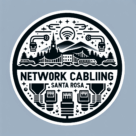What Are the 5 Types of Cable? A Complete Guide to Network and Electrical Wiring
If you’ve ever set up a network, installed new lighting, or connected an entertainment system, you’ve probably worked with cables — but not all cables are the same. Each type serves a unique purpose depending on speed, distance, and application.
In this guide, we’ll break down the five main types of cable, explain how they’re used, and help you choose the right one for your home, business, or structured cabling system. Our skilled structured cabling professionals in Santa Rosa specialize in installing reliable and efficient network systems for businesses of all sizes.
1. Coaxial Cable
Coaxial cable (or coax cable) has been a reliable choice for decades. It features a central copper conductor surrounded by insulation, shielding, and an outer jacket.
Common uses:
- Cable TV connections
- Internet service (from ISPs)
- CCTV security systems
- Radio transmitters and antennas
Advantages:
- Durable and resistant to interference
- Can transmit signals over long distances
- Widely available and easy to install
In structured cabling and home entertainment setups, coaxial cables remain a go-to for delivering high-quality audio and video signals.
2. Twisted Pair Cable
This is one of the most common cables used in data networks — especially Ethernet cabling like CAT5e, CAT6, and CAT6a. Twisted pair cables contain pairs of copper wires twisted together to minimize electromagnetic interference.
Common uses:
- Computer networks (LANs)
- VoIP phones
- Security and surveillance systems
- Data centers
Types:
- Unshielded Twisted Pair (UTP): Common in office and home networks.
- Shielded Twisted Pair (STP): Provides extra protection from interference in industrial environments.
Advantages:
- Cost-effective and easy to install
- Supports high-speed data transmission
- Compatible with modern network standards
If you’re setting up structured cabling for your office or smart home, CAT6 or CAT6a twisted pair is the preferred choice for performance and reliability.
3. Fiber Optic Cable
Fiber optic cables are the gold standard for high-speed data transfer. Instead of copper, they use glass or plastic fibers to transmit data as light signals — which means ultra-fast speeds and immunity to electrical interference.
Common uses:
- Internet backbone connections
- Data centers and telecom networks
- Long-distance communication
- High-security environments
Advantages:
- Extremely high bandwidth (up to 100 Gbps and beyond)
- Immune to electromagnetic interference
- Supports very long-distance transmission
- Future-proof for expanding network needs
Fiber optics are becoming more common in California structured cabling installations as businesses demand faster, more reliable connectivity.
4. HDMI Cable
HDMI (High-Definition Multimedia Interface) cables transmit both audio and video signals through a single connection. They’re essential for modern TVs, computers, and entertainment systems.
Common uses:
- Connecting TVs, projectors, and monitors
- Gaming consoles and streaming devices
- Conference room A/V systems
Advantages:
- Supports 4K and even 8K resolution
- Easy plug-and-play setup
- Combines audio and video in one cable
HDMI cables are crucial in residential setups and business environments that rely on clear video presentations and digital signage.
5. USB Cable
The USB (Universal Serial Bus) cable is the everyday connector we use for charging devices, transferring data, and linking peripherals.
Common uses:
- Charging phones and tablets
- Connecting printers, keyboards, and external drives
- Data transfer between devices
Advantages:
- Universal compatibility across devices
- Supports data and power transmission
- Constantly evolving with faster standards (USB-C, USB 3.2, USB4)
With the rise of smart devices, USB cables have become essential for both power and data in homes and offices.
Bonus: Specialized Cables You Might Encounter
Aside from the five primary types, there are a few others worth mentioning:
- Power cables for electrical wiring and appliances
- Audio cables like XLR and RCA for sound systems
- Patch cables for connecting network switches and patch panels
Each serves a specific role, and professionals often mix different cable types within the same structured system for optimal performance.
Choosing the Right Cable for Your Needs
Selecting the right cable depends on:
- Purpose: Data, video, or power
- Distance: Short vs. long-range transmission
- Environment: Indoors, outdoors, or industrial settings
- Speed requirements: Basic connectivity or high-speed networking
For most modern installations, a combination of CAT6 twisted pair and fiber optic cabling offers the best balance of speed, reliability, and scalability. Among these options, some cables are more widely used than others — learn more about the two types of cables most commonly used for network connections today.
Final Thoughts
Understanding the different types of cables helps you design stronger, faster, and more efficient network systems. Whether you’re connecting a few devices at home or wiring an entire office building, choosing the right cable ensures smoother performance and fewer connectivity issues.
If you’re planning a new installation in California, consider working with certified structured cabling professionals who can help design a network tailored to your needs.
